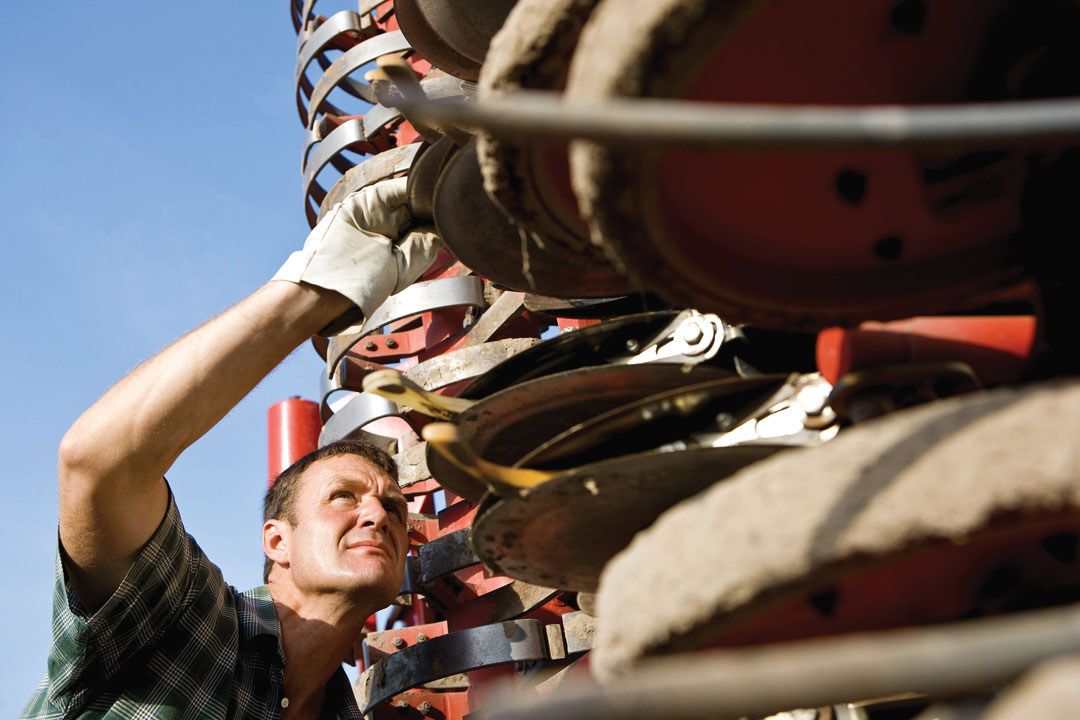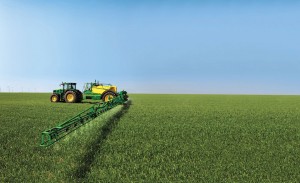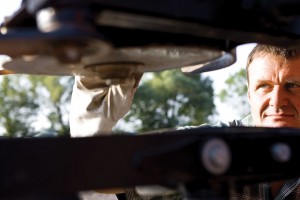SAFETY FIRST
OCCUPATIONAL HEALTH AND SAFETY IN THE WORKS FOR ALBERTA FARMS
BY SCOTT ROLLANS
Occupational health and safety (OHS) is coming soon to an Alberta farm near you.
If you’re surprised, you shouldn’t be. Our province is the only one in Canada where farm workers do not fall under OHS regulations, though the former Progressive Conservative government had been moving (very slowly) to bring Alberta in line with the rest of the country. Then, Premier Rachel Notley made OHS an issue during last spring’s provincial election. “[Farm workers] work without the right to organize; take rest periods; or receive the minimum wage, safety protections or mandatory workers’ compensation coverage,” she pointed out in a statement released April 28, just a week before the NDP’s stunning electoral victory. In July, Oneil Carlier, agriculture and forestry minister, and Lori Sigurdson, jobs, skills, training and labour minister, made it clear that the new government would be moving ahead with changes sooner rather than later.
Reactions from labour, industry representatives and producers have ranged from enthusiasm to grudging acceptance. However, virtually everyone recognizes that the change was inevitable. Everyone would agree that safety is a good thing.
Agriculture, like all industries, carries risk. According to Canadian Agricultural Injury Reporting, 1,975 accidental agricultural deaths were recorded in Canada between 1990 and 2008. Fatality rates have been declining in recent years, but it seems obvious that even one preventable farm fatality is one too many.
At the same time, the prospect of major regulatory changes—especially ones initiated by a labour-friendly government—was bound to make some in the industry uneasy. Carlier is eager to put those worries to rest. “We’re the new cowboy in town,” he admitted. “We’re going to make sure we have proper consultations with farm workers or producers, small or large.”
So far, Carlier has been heartened by the reception he has received. “I’m very optimistic [from] the folks I’ve talked to. They have a few misgivings about how things are going to work. For the most part, people are not only realizing this is going to happen, [but also] looking forward to it, because it’s the right thing to do.”
Formal consultation began in late June, when Carlier and Sigurdson met with representatives for farmers and ranchers. Sigurdson’s department will be responsible for the nitty gritty of any changes—things like the right to organize (unionize), minimum wage, restrictions on the number of hours worked, and mandatory workers’ compensation coverage—but she insisted that her first job is to listen. “There’s no master plan that we have hidden in the bottom drawer that we’re going to pull out,” she said. “We really want to create this in a collaborative way with the farm and ranch sectors.”
Ron Axelson, a consultant with the Intensive Livestock Working Group of Alberta, was at the June meeting. He said that his group had been moving toward OHS long before the new government arrived on the scene. “We’ve actually been working on this issue for over two years, and I think we do have a fairly strong consensus—on the livestock side of things anyway—that change is required.”
Axelson and his colleagues have a fairly clear idea of how they’d like things to proceed. “We want to move forward in a staged or incremental basis, starting with fatality and serious incident reporting,” he said. Currently, OHS has no mandate to investigate injuries or deaths on farm worksites.
Next, farmers and ranchers hope to work collaboratively with government to develop technical OHS standards aimed specifically at farming. “The main worry is that the exemption will be removed and that suddenly agriculture will be under exactly the same technical rules as the rest of the general industrial sectors,” said Axelson. “That isn’t going to work for agriculture, because there are some very unique circumstances.”
Axelson also worries that workers’ compensation coverage may be mandated across the board—in some cases displacing private insurance that he said actually provides better coverage for workers. “We’re afraid that there will be some kind of draconian regulation brought in that says everybody should be under [the Workers’ Compensation Board], and that’s the end of it.”
Overall, though, Axelson welcomes the move towards OHS on farms, particularly if it’s backed by the training and support to foster an overall culture shift. “A regulation, on its own, will do nothing,” he argued. “It’s the implementation of a philosophy, or mindset, of farm safety that’s going to make the difference.”
Sharon McKinnon, head of the Crop Sector Working Group, attended the June meeting as well, and came away with a similar list of hopes and concerns. She would like to see the government spend at least a couple of years working with industry to develop technical standards for farming and ranching. “It’s not the same as construction. It’s not the same as the oil and gas industry,” she said.
McKinnon felt that the initial consultation went a long way towards quelling people’s lingering apprehension. “The meeting was very well attended—I think the industry was well engaged, and they appreciated having the ministers there for the entire morning to hear about industry concerns. It went very well,” she said.
The view to the east
Clearly, a lot of work remains in the months and years ahead. But, if Alberta’s two provincial neighbours to the east are any indication, Alberta’s agriculture industry should be able to manage the transition without too much upheaval.
In Manitoba, agriculture was rolled into provincial workplace, health and safety rules in 2009. Although there’s no clear evidence yet of a decline in provincial accident and fatality rates, farmers and ranchers seem to have adapted just fine.
“I have to give the province credit,” said Doug Chorney, former president of Keystone Agricultural Producers (KAP), Manitoba’s provincial farm policy association. “They’ve actually been very patient with us, and helped us come into compliance. They haven’t pushed hard enforcement intensely at us. Certainly, if there’s an incident on a farm, there are no exceptions made, but, by and large, the province has tried to work with us.”
Chorney points to the province’s regional agricultural safety officer based in Brandon, who has made a point of interacting with local farmers rather than just showing up at the gate brandishing a clipboard and a red pen. “He’s been really good to work with,” said Chorney. “He is a really down-to-earth, farm-background person. He’s been attending meetings and just sort of showing farmers that there’s not a big monster coming to see them.”
The shift to OHS in Manitoba was easier for large operators, Chorney said. “For a lot of our more sophisticated farm employers—people running intensive livestock operations, for example, and sometimes affiliated with a company like Maple Leaf Foods—this was not a big step to take, because they were doing a lot of things in their processing plants already, and they had the HR capacity to help their farm operations adapt quickly.”
Like Axelson in Alberta, many in Manitoba were concerned about the prospect of mandatory workers’ compensation. “We felt the private sector offered us a lot of alternatives to [workers’ compensation] that were competitive and appealing to many of our members. However, around January 2009, we went to mandatory inclusion,” said Chorney. Once the decision was made, KAP and others shifted their efforts to negotiating a fair rate—which was then locked in for the first two years, to give the sector a chance to adjust. “We did a pretty good job—our rates have been pretty stable.”
Chorney thinks the changes have helped make safety a priority for Manitoba farmers, even if it’s not yet reflected in the statistics. “I’m really seeing a cultural shift away from something like, ‘Don’t talk to me, this isn’t my problem, I’m busy in the field,’ to, ‘You know, maybe I do want to learn about this.’ People learn that it’s not a big bridge to cross.”
He has even noticed a change in his own attitude. Recently, Chorney attended a KAP-sponsored safety workshop, and suddenly found himself looking around his farm with fresh eyes. “I came back from that meeting, and I had a broken stepladder I was using by my fuel tanks,” he recalled. “I threw it away. It cost me $75 to buy a new ladder. It’s a simple thing to do. Really, I shouldn’t be climbing on a broken ladder, right? That’s stupid.”
In Saskatchewan, farms have long fallen under provincial OHS regulations. Harvey McEwen, a veteran grain farmer in southeastern Saskatchewan, said that most farmers don’t give it much thought. “I don’t think our farm is much different than anybody else’s, in that we have attempted to be safe for the last hundred years,” he said. “Nobody wants to get hurt.”
All the same, McEwen empathizes with the anxiety currently felt by some Alberta farmers and ranchers. “I suppose, like most farmers, we’re not anxious to have more regulations put on our businesses than we already have,” he said. “But this is one area where farms do have to catch up—particularly now that farms are becoming larger and more commercial, and have employees, not just casual, weekend family members helping out.”
McEwen’s son Blair wonders if some Saskatchewan farmers are aware that they even have official safety responsibilities. “I think, for the most part, nobody really feels affected by it at all,” he said. “It’s still extremely relaxed on the ag side when it comes to rules and regulations for health and safety.”
Although workers’ compensation coverage is optional in the province, Blair recently opted in for the employees on his family farm. He was grateful to have it this past winter, when a worker injured his back after slipping on some ice. “He hasn’t worked since February,” Blair pointed out. “Who’s going to pay his bills?” Since then, he has been spreading the word. “I try to preach that to everyone I know—go get workers’ compensation. It’s cheap, it’s reliable.”
Ahead of the game
McEwen would get no argument from Michael Kalisvaart. Kalisvaart runs a 12,000-acre grain operation near Gibbons, AB, employing eight or nine people year-round and about 15 during harvest. He had been relying on a private insurance provider to cover his staff, but voluntarily switched to workers’ compensation to provide more extensive protection. He had worried that it might be expensive or come with too many requirements. “Our impression was that there was a lot of interference as far as requiring safety regulations and things like that—that they would cost us a fair bit of money to get our farm up to a safety code similar to other commercial enterprises. But we found they were very reasonably priced,” he said. Kalisvaart thinks the farm is almost ready for a Workers’ Compensation Board safety audit, which would reduce costs even further.
Workers’ compensation coverage reduces Kalisvaart’s own liability exposure, but he insists that the switch was more for his employees’ sake. “It was more income protection—that if something did happen, they would have good coverage, and we wouldn’t have the heartache and the guilt of having somebody struggle for the rest of their life with their income,” he said.
For other farmers who wish to stay ahead of the issue, the Government of Alberta recently completed a successful pilot for its Alberta FarmSafe Plan. The program offers extensive learning resources, along with training and consulting services. Grants are also available. The goal is to help farmers develop health and safety systems for their businesses. With a solid safety plan in place, producers should be well positioned to meet the requirements of any new OHS regulations.
In the meantime, Sigurdson promises ongoing consultation, clear communication and a measured, gradual approach. “Everybody doesn’t have to turn on a dime—all of a sudden the legislation’s changed, and now you have to change by tomorrow,” she said. “Clearly, we are looking at an approach that is respectful of giving farm and ranch folks an opportunity to make the shift.”









Comments